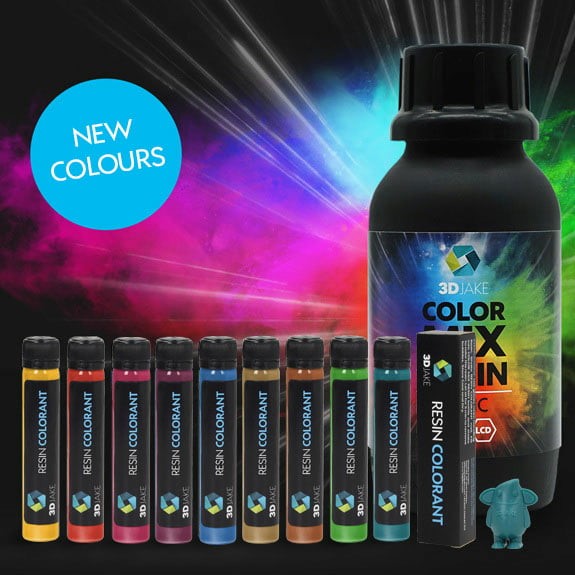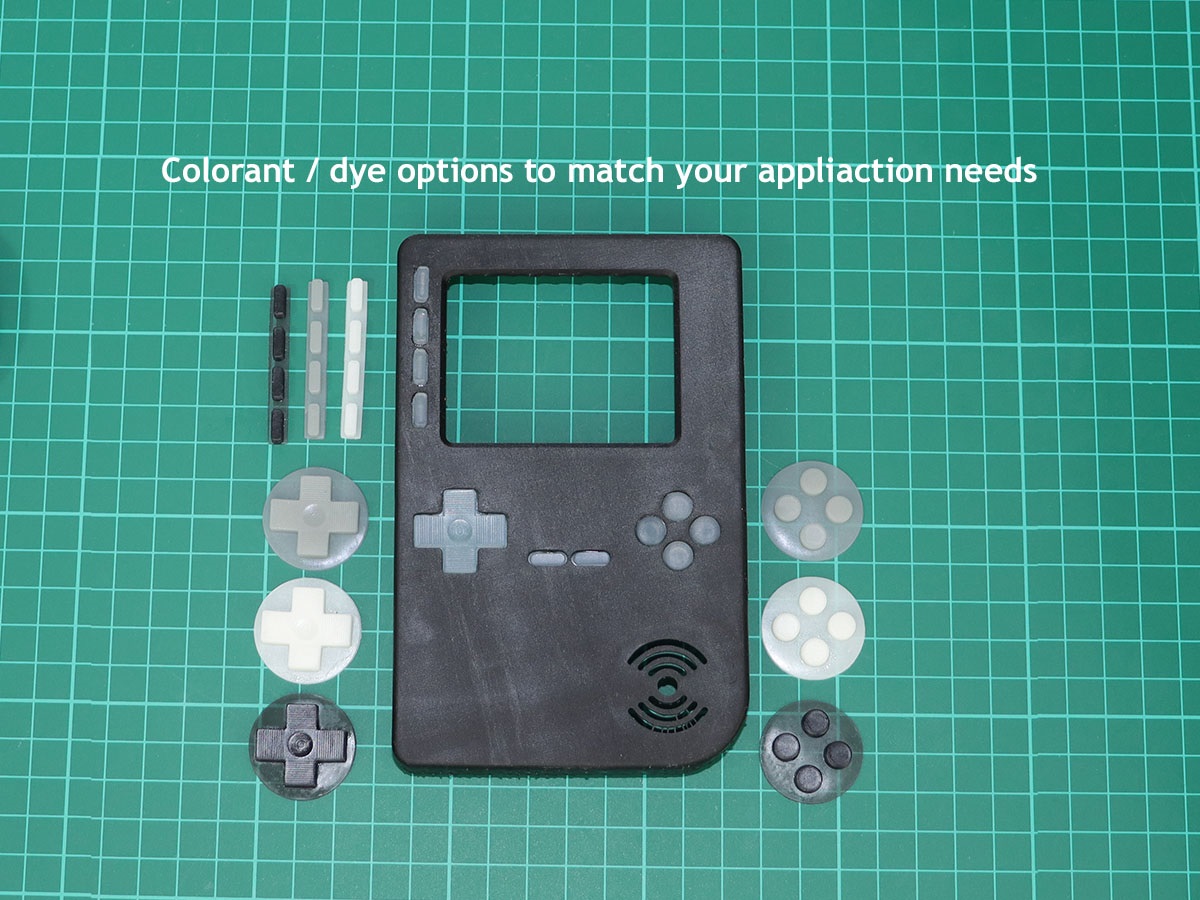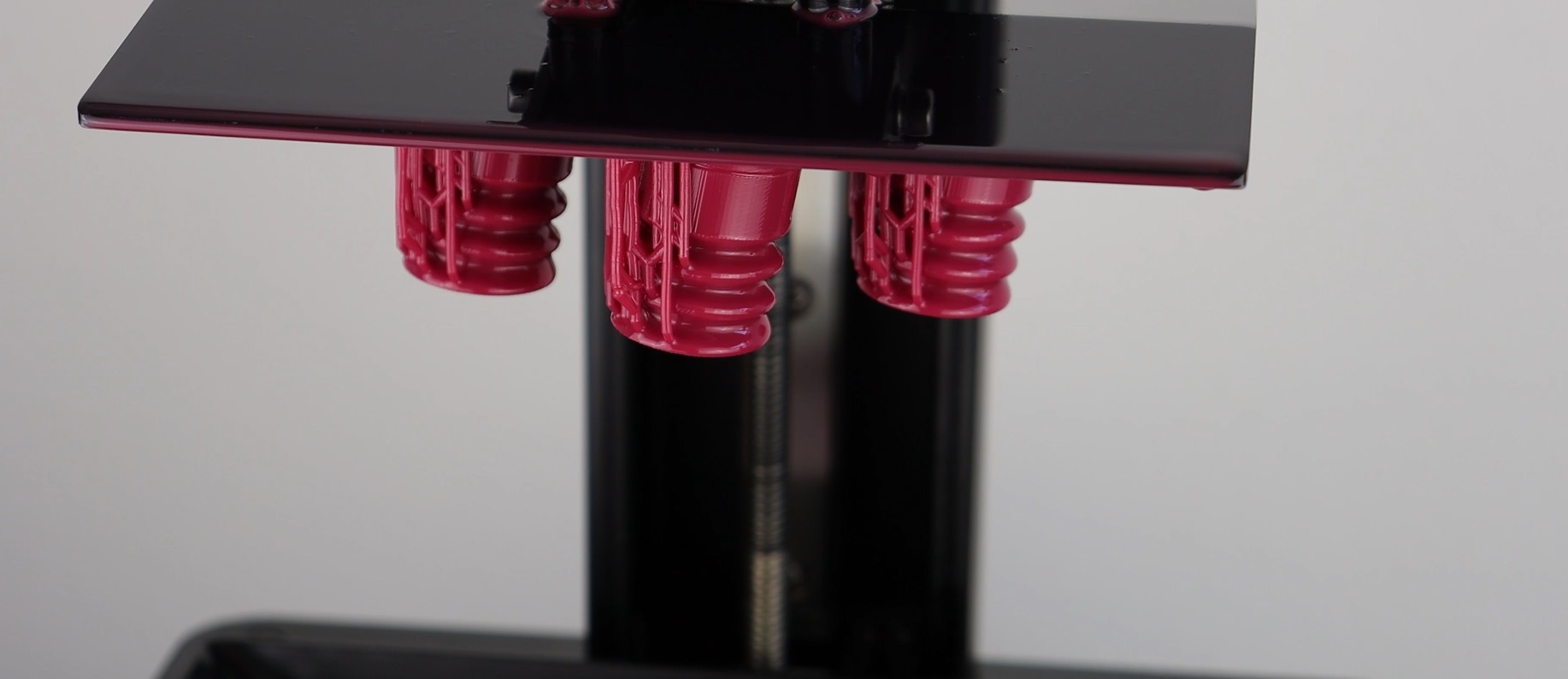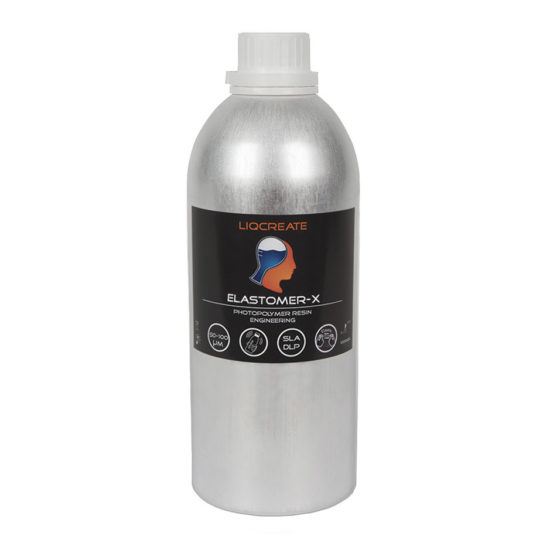Our high-end photopolymer resins are used in a wide range of industries including prototyping, industrial, entertainment, consumer goods, healthcare, dental, aerospace and automotive. Even though a lot of resins are available, sometimes we get questions about resins with colors that are not available in our commercial resin range. For bigger volumes, we offer custom development, OEM, Private label and white label possibilities. In this article we test and explain how to color Liqcreate Elastomer-X photopolymer resin.
When you just need a couple kilogram resin, it is difficult to customize a product and take it into our production. Therefor some of our customers started asking questions about coloring resins. A coloring guide for Premium Tough, Clear Impact and Premium Flex were published earlier and can be found in this link. Coloring is easiest when starting with translucent colors and resins that have a high reactivity. Properties of the resin can change when using colorants, like pigment stability, print speed and mechanical properties. In this article we tested a few different 3D-printing resin colorants and resin dyes from 3DJake. Likely other commercial colorants that are specifically marketed for resin 3D-printing will also work well.

Image by 3DJake, commercial resin dyes for resin 3D-printing
Before starting coloring 3D-printing resins
It should be noted that we at Liqcreate are not in favor that our customers are coloring resins as colorants can change the resin and sometimes require quite a bit of experimentation. Although for very low volumes, it is not possible to develop or produce a formulation. If the volumes are increasing, contact us to see if we can manufacture the resin formulation in our factory. There are several reasons to have the resins mixed in a factory, and some points of attention if you decide to mix the resins yourself.
First of all, when working or mixing resins, always wear the right personal protection equipment. This information and more safety information can be found in the safety data sheet (SDS) of the resin. Also work in a well ventilated area. Before coloring resins, make sure that the original resin is shaken properly. If resin or colorant is not homogeneous before mixing, it is almost impossible to duplicate results. Next to this, make sure that the weighing instrument is calibrated and accurate.
Experimenting with colorants in Elastomer-X
Elastomer-X is a clear liquid. When you print parts with it, you will end-up with a clear, slightly hazy rubber part. If your project requires a different color, it is possible to mix this resin with a 3D-printing resin colorant. That would be ideal if you want a black elastic or rubber-like part or any other color. With a bit of effort, the material should mix homogeneous with the colorant, due to the natural color of the polymers itself. Three main points of focus will be:
- – Are the pigments stable for longer prints?
- – Are the mechanical properties influenced by the colorant?
- – Is the print speed significantly reduced by the colorant?
Two 3D-printing colorants were selected and ordered from 3DJake:
- – Deep Black
- – Light Grey
In an earlier study we saw that translucent pigments did not really do anything in terms of print behaviour or properties. Mostly colorants that either absorb or block the light emitted by the 3D-printer are the ones to keep extra attention on. For 405nm printers these colors are: yellow, orange, black and any opaque color.
In this previous study we also added colorants to Liqcreate Clear Impact, which is somehow similar in print speed compared to Elastomer-X. Here we found that the maximum recommended loading level of 2,5 weight percentage was too high and print speed was completely ruined. After halving it to 1,25% the tests were continues. With this experience, we start at 1,25% loading level. Right after weighing the liquids colorants in the resin, it was apparent that the colorants are compatible with Liqcreate Elastomer-X resin and could be mixed in by shaking the resin bottle with colorants for a couple minute until a homogeneous mixture was obtained.
Mechanical test specimen were printed on an Elegoo Mars 3. Simultaneously the optimal exposure time for 0,1mm layer height was recorded. This was done because coloring resin will likely have an influence on the exposure times.
Table 1: Exposure times of colored Premium Tough resins at 0,1mm layer height on the Elegoo Mars 2
| Resin | Print time (seconds) at 0,1mm layer height |
| Elastomer-X | 16,0 sec |
| + 1,25 % Deep Black resin Colorant | 20,0 sec |
| + 1,25 % Light Grey resin Colorant | 20,0 sec |
For the opaque resin colorants at halve of the maximum loading level, an additional 4 seconds were needed to cure a layer of 0,1mm. Please note this could be different for each printer. On printers with an RGB screen, the increase in exposure time is expected to be significantly higher. With this test data it is highly advised to not add more colorants as the print time will increase much more.
Pigment stability of colored Elastomer-X
When we develop a colored resin at Liqcreate, we always stabilize the resins in order to prevent pigment sagging and settling as much as possible. When adding resin colorants from unknown chemical nature into a clear and unstabilized resin, it is always difficult to predict the outcome. The stability tests was performed during and after the 3D-printing process in the Elegoo Mars 3. We printed mechanical test specimen, which took about 13 hours. After that we waited for 11 hours so the total time the pigments could settle was about 24 hours. The bottom of the resin tank was inspected after this time. Some minor sagging was found for the black and grey pigment. This did not influence the 13 hour print, as the part quality was great.
Black, White and Grey Elastomer-X coloring resin
This method is suitable if you need a black elastomer part, white rubber-like photopolymer resin or grey engineering soft TPU material. Just add the corresponding colorants to Elastomer-X and color it in (almost) any color you want. After testing we advise to be carefull with using the maximum loading level of the colorants. With halve of the loading level, it can be that thin parts look slightly translucent colored. In the pictures below you can see how elastic black, white and grey parts look liks.

Using colorants for coloring Liqcreate Elastomer-X. When you need a black rubber -like resin or grey elastomer, the options are endless with colorants.
For our Elastomer-X launch video we made an opaque red industrial part when mixing red, white and black colorant. Due to the opaque nature of the part, we had to add an additional 8 seconds on top of the regular print time. This is quite long, but the result with this colorant in Elastomer-X is beautiful.

Coloring of Liqcreate Elastomer-X with colorants. Parts with additional resin colorant. when you need a black rubber -like resin or grey elastomer, the options are endless, for instance the opaque red coloring industrual part that we produced for our introduction video and use-case.
Mechanical properties of coloring Elastomer-X.
The mechanical properties of Elastomer-X resin with colorants were investigated. From the test it was found that coloring Elastomer-X with half of the maximum loading level for black and grey pigment yielded quite similar results. All properties were within 10% deviation from the transparant clear resin.
Benefits of using a colorant for coloring Elastomer-X 3D-printing resin
Next to appearance, coloring resin might bring other benefits. Opaque pigments and , black, yellow and orange colorants can block the 405nm light during 3D-printing. This will increase the exposure time needed to print, but in most cases also increases the accuracy. By blocking more light during printing, a more defined depth cure for each layer can be reached. This usually results in less through-cure or bleeding and has a positive effect on the accuracy.
We hoped this was an interesting and educational read. Please send us an e-mail at info@liqcreate.com if you have any questions, comments or remarks. We wish you happy printing and have fun with your colored resin!
Support
Do you need any help with 3D printing our SLA, DLP or LCD resins? We can help you! Just look for the question you have below. If you can’t find it, let us know by contacting us!
Printer Settings →
Elastomer-X
Liqcreate Elastomer-X is a clear photopolymer resin and can be processed on MSLA (LCD), DLP and laser based 3D-printers. 3D-printed parts from this material are exceptionally soft with a Shore A of 43 and have great flexibility. The product can be used as received, or colored with almost any commercial available 3D-resin colorants. Liqcreate Elastomer-X is can be used on open DLP, LCD and SLA 3D-printers in the range of 385 – 420nm. Its properties simulate soft TPU and silicone which makes it perfect for the production digital lattice foams, soft end of arm tooling (EOAT) for robots, grommets, bellows and elastic industrial parts.
Key benefits |
3D-Printer compatibility |
| · High Elongation | · Shining3D Accufab-L4K |
| · Mimics silicone and soft TPU | · Phrozen & Anycubic series |
| · Low Shore A hardness | · Elegoo & Creality series |
| · Ideal for soft digital lattice foams | · And many more |



